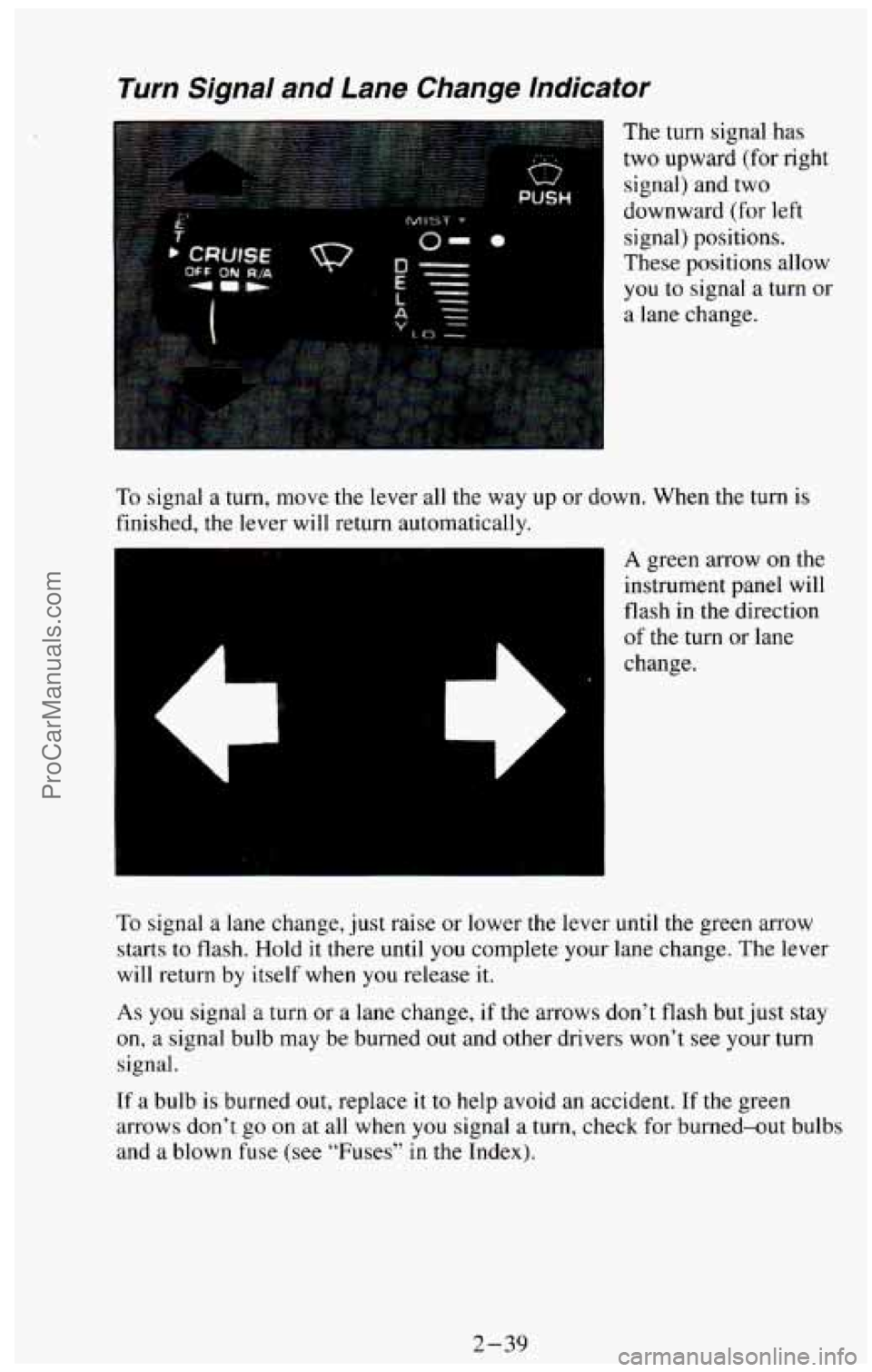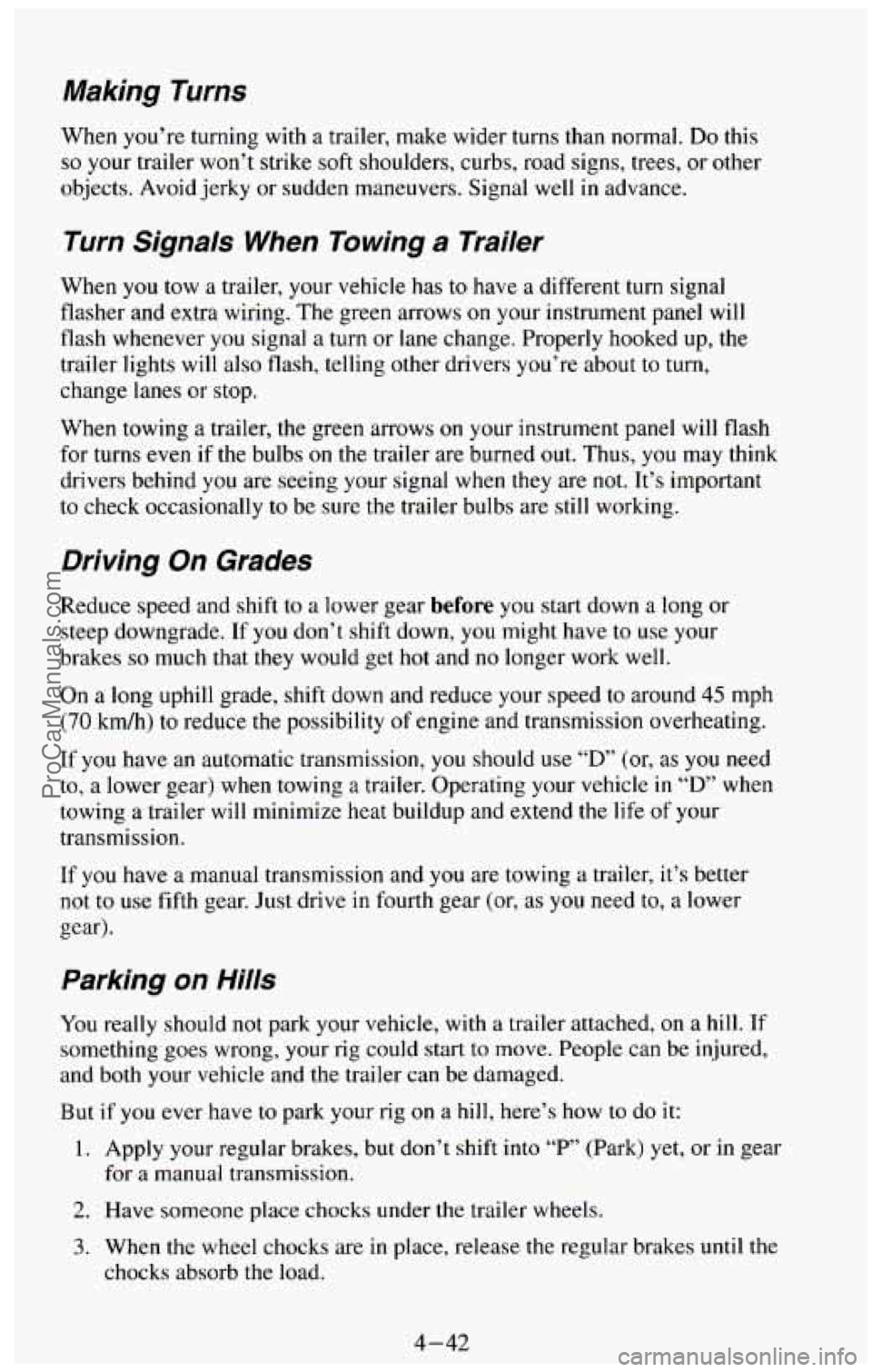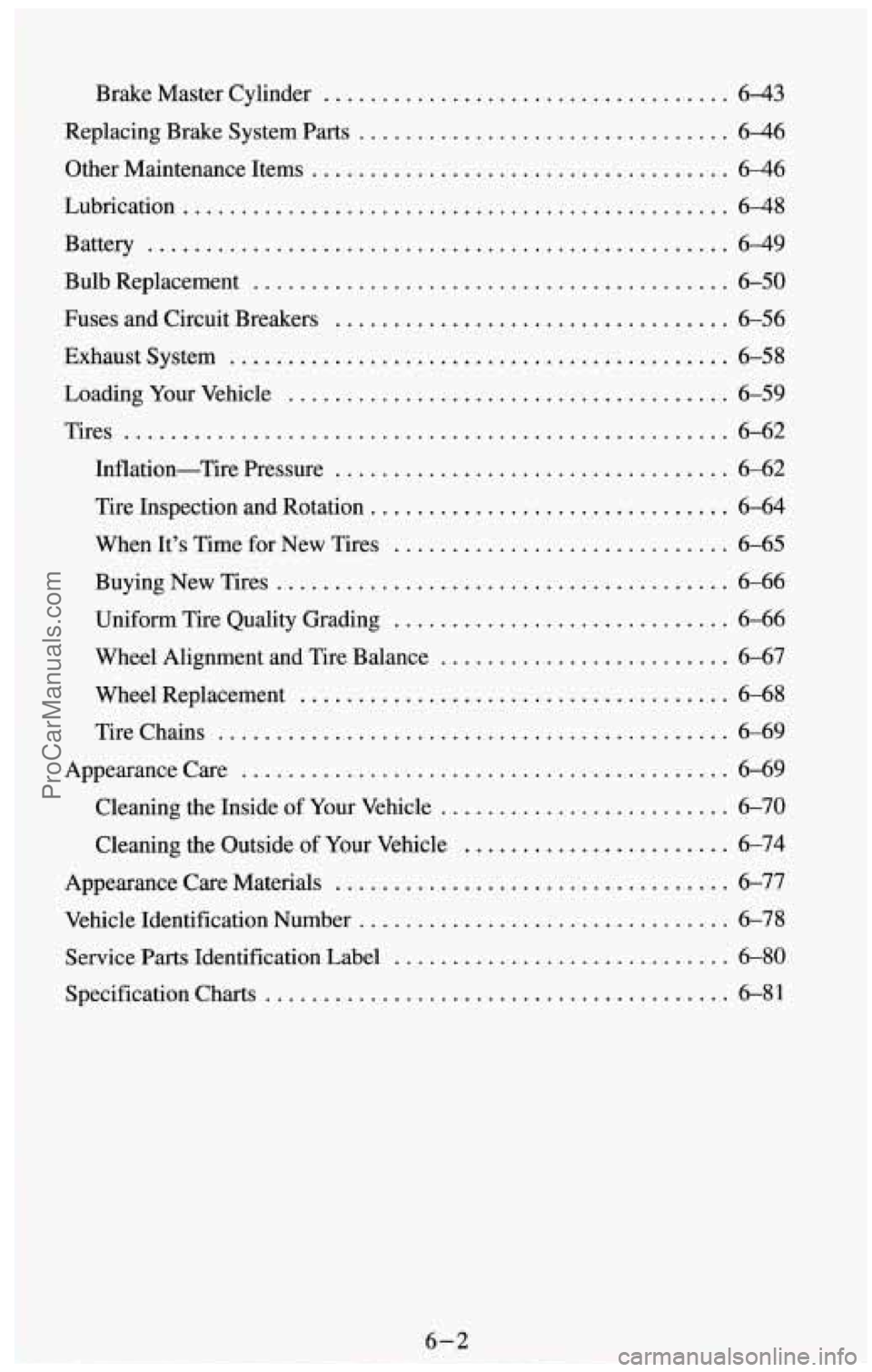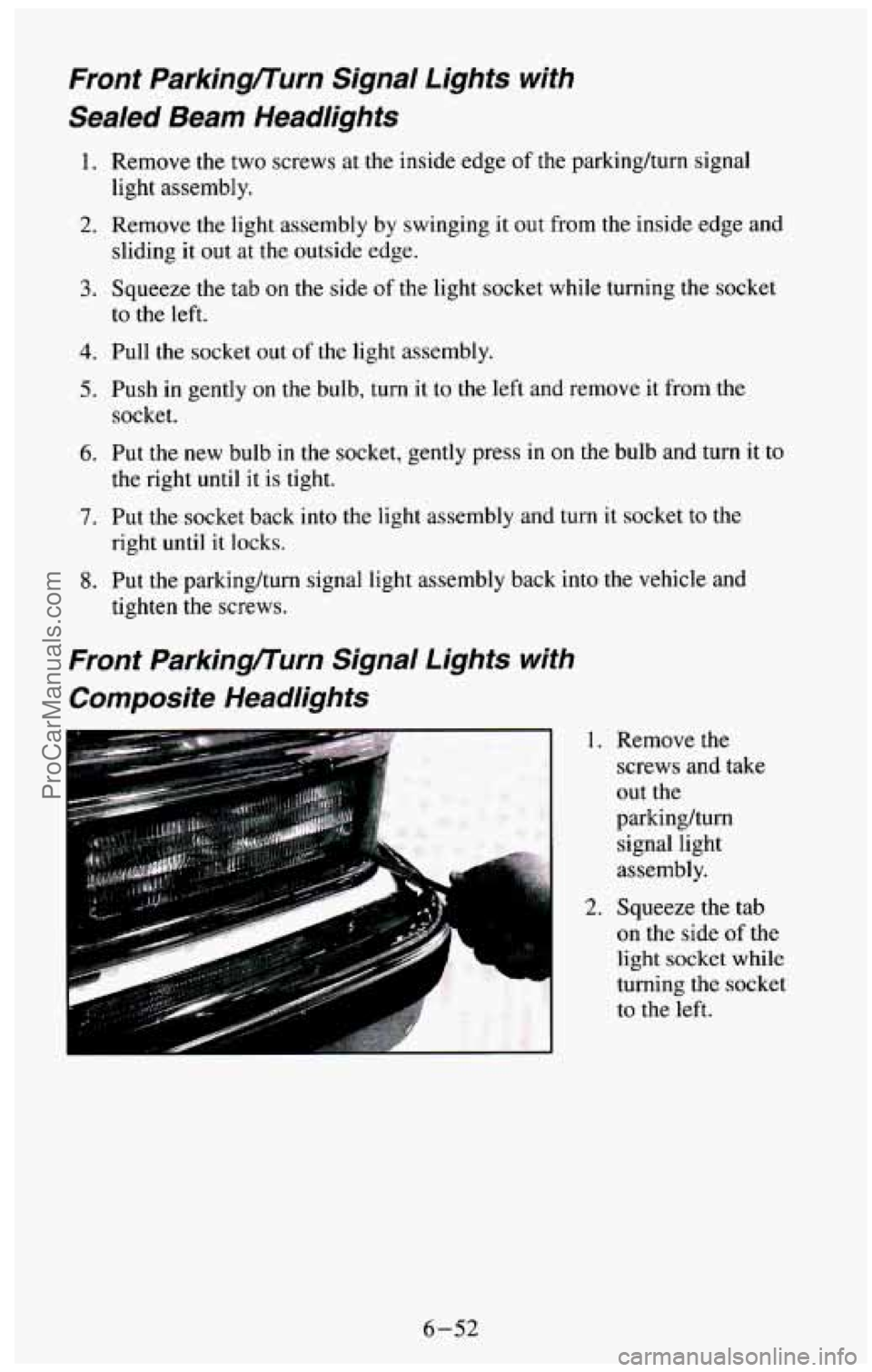Page 94 of 385

Turn Signal and Lane Change lndicator
The turn signal has
two upward (for right
signal) and two
downward
(for left
signal) positions.
These positions allow
you to signal a turn or
a lane change.
To signal a turn, move the lever all the way up or down. When the turn
is
finished, the lever will return automatically.
A green arrow on the
instrument panel will
flash in the direction
of the turn or lane
change.
To signal a lane change, just raise or lower the lever until the green arrow
starts to flash. Hold it there until
you complete your lane change. The lever
will return by itself when
you release it.
As you signal a turn or a lane change, if the arrows don’t flash but just stay
on, a signal bulb may be burned out and other drivers won’t see your turn
signal.
If a bulb is burned out, replace it to help avoid an accident. If the green
arrows don’t
go on at all when you signal a turn, check for burned-out bulbs
and a blown fuse (see “Fuses” in
the Index).
2-39
ProCarManuals.com
Page 201 of 385

Making Turns
When you’re turning with a trailer, make wider turns than normal. Do this
so your trailer won’t strike soft shoulders, curbs, road signs, trees, or other
objects. Avoid jerky or sudden maneuvers. Signal well
in advance.
Turn Signals When Towing a Trailer
When you tow a trailer, your vehicle has to have a different turn signal
flasher and extra wiring, The green arrows on your instrument panel will
flash whenever you signal a turn or lane change. Properly hooked up, the
trailer lights will also flash, telling other drivers you’re about to turn,
change lanes or stop.
When towing a trailer,
the green arrows on your instrument panel will flash
for turns even if the bulbs on the trailer are burned out. Thus, you may think
drivers behind you are seeing your signal when they are not. It’s important
to check occasionally
to be sure the trailer bulbs are still working.
Driving On Grades
Reduce speed and shift to a lower gear before you start down a long or
steep downgrade. If
you don’t shift down, you might have to use your
brakes
so much that they would get hot and no longer work well.
On
a long uphill grade, shift down and reduce your speed to around 45 mph
(70 kdh) to reduce the possibility of engine and transmission overheating.
If you have an automatic transmission, you should use “D” (or, as you need
to, a lower gear) when towing
a trailer. Operating your vehicle in “D” when
towing a trailer will minimize heat buildup and extend
the life of your
transmission.
If
you have a manual transmission and you are towing a trailer, it’s better
not
to use fifth gear. Just drive in fourth gear (or, as you need to, a lower
gear).
Parking on Hills
You really should not park your vehicle, with a trailer attached, on a hill. If
something goes wrong, your rig could start to move. People can be injured,
and both your vehicle and the trailer can be damaged.
But
if you ever have to park your rig on a hill, here’s how to do it:
1. Apply your regular brakes, but don’t shift into “P’ (Park) yet, or in gear
for a manual transmission.
2. Have someone place chocks under the trailer wheels.
3. When the wheel chocks are in place, release the regular brakes until the
chocks absorb
the load.
4-42
ProCarManuals.com
Page 247 of 385

......................
................
Brake Master Cylinder ................................... 6-43
Replacing Brake System Parts .............................. 6-46
Other Maintenance Items .................................... 646
Lubrication ............. ..... 648
Battery ................ ....... 6-49
Bulb Replacement ......................................... 6-50
Fuses and Circuit Breakers ................................ 6-56
Exhaust System ....................................... 6-58
Loading Your Vehicle ...................................... 6-59
Tires .................................................... 6-62
Inflation-Tire Pressure .................................. 6-62
Tire Inspection and Rotation ............................... 6-64
When It’s Time for New Tires ......................... 6-65
Buying New Tires ..................................... 6-66
Uniform Tire Quality Grading ............................. 6-66
Wheel Alignment and Tire Balance ......................... 6-67
Wheel Replacement ..................................... 6-68
Tire Chains ............................................ 6-69
Appearancecare .......................................... 6-69
Cleaning the Inside of Your Vehicle ......................... 6-70
Cleaning the Outside of Your Vehicle ..................... 6-74
Appearance Care Materials .................................. 6-77
Vehicle Identification Number .............................. 6-78
Service Parts Identification Label ............................. 6-80
Specification Charts ...................................... 6-81
6-2
ProCarManuals.com
Page 295 of 385
Bulb Replacement
Before you replace any bulbs, be sure that all the lights are off and the
engine isn't running.
Sealed Beam Headlights
3. Unplug and
remove the
headlight.
headlight and put
it in place.
5. Install the
4. Plug in the new
retainer to the
headlight and tighten the
1. Remove the four
screws from the
headlight retainer.
2. Pull the headlight out and remove
the retainer.
screws.
Halogen Bulbs
6-50
ProCarManuals.com
Page 296 of 385
NOTICE:
Avoid touching the bulb or letting it come in contact with
anything damp. Oil from
your skin or moisture on the bulb can
cause the bulb to explode when it is turned on. If either comes in
contact with the bulb, clean
it with alcohol or a suitable
degreaser and wipe the bulb dry.
Composite Headlights
.' --6n k
'I
i 1. Remove the two
screws at the top
of the radiator
support.
2. Pull the headlight
lens assembly
out.
3. Unplug the
electrical
connector.
4. Turn the bulb to
the left and
remove it.
5. Put the new bulb in the lens assembly and turn it to the right until it is
6. Plug in the electrical connector.
7. Put the headlight lens assembly back into the vehicle. Install and
tight.
tighten the two screws.
6-51
ProCarManuals.com
Page 297 of 385

Front Parkingnurn Signal Lights with
Sealed Beam Headlights
1. Remove the two screws at the inside edge of the parkinghurn signal
light assembly.
2. Remove the light assembly by swinging it out from the inside edge and
3. Squeeze the tab on the side of the light socket while turning the socket
sliding
it out at the outside edge.
to the left.
4. Pull the socket out of the light assembly.
5. Push in gently on the bulb, turn it to the left and remove it from the
socket.
6. Put the new bulb in the socket, gently press in on the bulb and turn it to
the right until it is tight.
right until it
locks.
7. Put the socket back into the light assembly and turn it socket to the
8. Put the parkinghrn signal light assembly back into the vehicle and
tighten the screws.
Front Parkingnurn Signal Lights with
Composite Headlights
1. Remove the screws and take
out the
parkinghum signal light
assembly.
2. Squeeze the tab
on the side of the
light socket while
turning
the socket
to the left.
6-52
ProCarManuals.com
Page 298 of 385
the left and
remove it from
the socket.
5. Put the new bulb in the socket, gently press in on the bulb and turn it to
6. Put the socket back into the light assembly and turn it socket to the
7. Put the parking/turn signal light assembly back into the vehicle and
the right until
it is tight.
right until it locks.
tighten the screws.
Side Marker Lights with Sealed Beam
and Composite Headlights
1. Remove the screws and pull
out the
parking/tum signal light
assembly.
2. Reach through the opening and
turn the side
marker bulb socket to the left
and remove it.
6-53
- ProCarManuals.com
Page 299 of 385
3. Pull the bulb straight out
of the
socket.
4. Put a new bulb
into the socket
and push it in
until it is tight.
5. Put the socket back into the side marker assembly and turn it to the
right to tighten it.
6. Replace the parking/turn signal light assembly and tighten the screws.
Roof Marker Lights
1. Remove the
screws and lift
off
the lens.
2. Pull the bulb
straight out
of the
socket.
3. Put a new bulb into the socket and push it in until it is tight.
4. Replace the lens and tighten the screws.
6-54
ProCarManuals.com